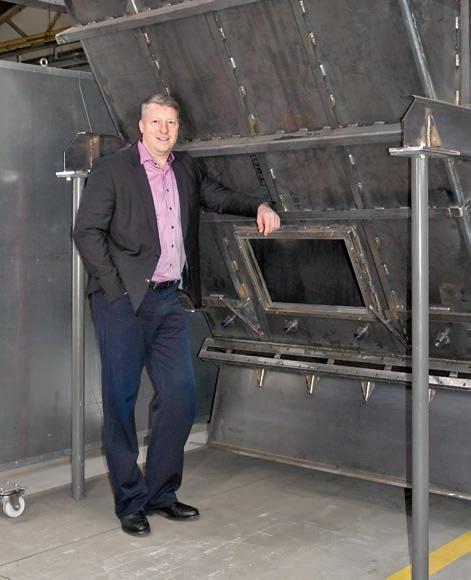
25 minute read
PLAYING THE GAME
Deeply rooted in the U.S
NEUHAUS NEOTEC ON ITS DEEP ROOTS IN THE UNITED STATES MARKET AND ADVANCED COFFEE ROASTING METHODS THAT STRONGLY IMPACT THE COFFEE INDUSTRY.
When former Neuhaus Neotec Managing Director Gustav Lührs was looking for the most advanced roasting solution in the United States, he was approached by Chemical Engineer and Coffee Industry Consultant Michael Sievetz, the inventor of fluid bed air roasting.
“Based on that roasting idea, Lührs and his team developed the rotational flex batch (RFB) technology and thus began the journey to a more sophisticated system of roasting,” says Neuhaus Neotec Head of Marketing Lars Henkel.
Henkel says Neuhaus Neotec’s former director has a very close relationship to the United States, having established the roasting method of RFB technology in the country.
Neuhaus Neotec’s RFB roasters allow the coffee beans to be moved solely by the air flow in the chamber, and the thermal energy of the roasting air is transferred homogeneously and directly into the beans.
“The RFB hot air roasters meet the demands of the increasing variety of coffees on the market like no other system. The gas heated RFB roasting systems are available in different versions depending on the roasting capacity, from 30-kilogram batches to 450-kilogram batches with roasting capacities of up to 4500 kilograms per hour,” says Henkel.
With this capacity range, Neuhaus Neotec meets the demand of industrial roasters with high volumes of roasted coffee as well as the needs of smaller specialty coffee roasters with lower quantities but high-quality demands on the roasting process and maximum flexibility in roasting profiles.
Moreover, the RFB roasting technology shows its full advantages when it comes to flexibility and control of roasting profiles and
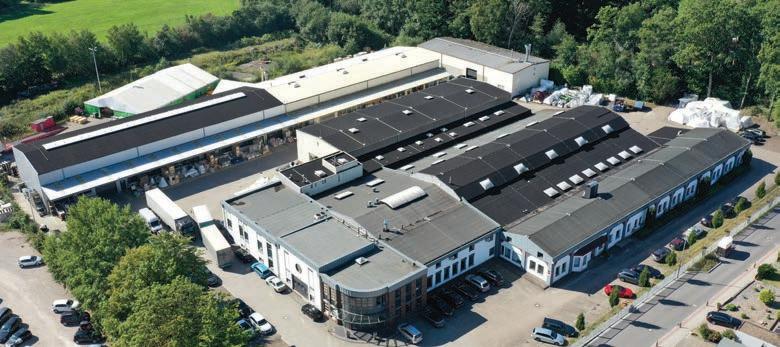
The Neuhaus Neotec headquarters in Ganderkesee, Germany, with offices, several production halls, a testing centre and areas for expansion.
energy consumption. The direct heat transfer from the heated air into the bean led to shorter response times of the system and therefore allows maximum flexibility in designing the roasting curve.
Within the last few years, Neuhaus Neotec together with a leading roasting company, have developed an additional patented feature that extends the range of profiles to uncommon curves and a maximum control of the undesired acrylamide formation during roasting.
“Chemical components in the coffee are moved more into the focus and are increasingly regulated by the authorities, this new feature called Triple-A is of great interest in the coffee industry,” says Henkel.
In order to follow the requirements of minimum energy consumption, Neuhaus Neotec has also optimised its main energy consumption, through burners with high modulation range, the closed and leakage-free circulation of hot gas, and exhaust cleaning systems with minimum demand for additional heat energy for chemical reactions.
Today, Henkel says the RFB roaster is the most energy efficient roaster in its capacity class. Cleaning the exhaust gas has also been made less energy-intensive thanks to new exhaust cleaning technologies that have been adapted to the RFB roasting system.
“Neuhaus Neotec is proud to supply a large US roaster with the RFB technology in combination with preheating and a regenerative thermal oxidation (RTO) for exhaust treatment, which reduces the total energy consumption clearly in the multidigit range,” says Henkel.
As well as this, for catalytic cleaning systems the reaction temperature can be reduced to a lower temperature level, which means savings in gas consumption.
“In many large roasting plants, the RFB roasters are now a part of the standard equipment for a wide variety of coffee products, from specialty roasting to instant coffee production,” Henkel says.
He adds that another long-standing US customer that has relied on RFB technology for many years has just ordered an upgrade of its existing machines.
Ralf Torenz, Director of the Coffee Division and President of Neuhaus Neotec USA, sees this as a great sign of confidence in the cooperation, but also in the future orientation of the technology.
Henkel says Ralf Torenz is responsible for the sales activities in the US and has a close relationship to the company’s customers overseas.
“He feels very connected to the American community and sees the United States as a country with a strong coffee culture. From the beginning the US customers were open to new roasting technologies, which was one of the reasons why RFB technology was also able to achieve initial success in the US market very early on,” Henkel says.
The topic of alternative energies remains prevalent in the production industry not only in the US and Europe but worldwide, noting the current price development for fossil energies is also contributing to thoughts on new technologies.
Neuhaus Neotec addresses this challenge with its latest development and soon-to-bereleased large full electrical roaster, which will first launch in America.
Henkel says the company’s entry into roaster development began on the American continent and will possibly experience its next big leap there.
“Due to this special relationship with the US roasting industry, it was always a matter of the heart to be present in the US market, and it has led to the first company expansion with its own office and service team in Atlanta,” Henkel says.
“The US is such a diverse country, and different parts of the country are looking for different things. The market also changes very fast, so what you need to provide today is flexibility.”
For roaster operators, that flexibility is reflected in the opportunity to conduct a short or long roast, light or dark, and all with energy efficient options.
While the company’s entry into roaster development may have begun in the US, the German manufacturer has now established itself as one of the world’s largest suppliers for coffee handling and roasting manufacturing equipment.
“Since its beginning, Neuhaus Neotec has constantly developed different roasting technologies and provides some of the most efficient roasting machines on the market,” says Henkel.
“Whether roasting, grinding or the entire handling, we are constantly developing new solutions in order to optimise the processes for our customers. Our goal is to get the best out of the bean across all process steps.” GCR
Ralf Torenz, Director of the Coffee Division, in front of Neuhaus Neotec’s RFB chamber in production.
For more information, visit www.neuhaus-neotec.com
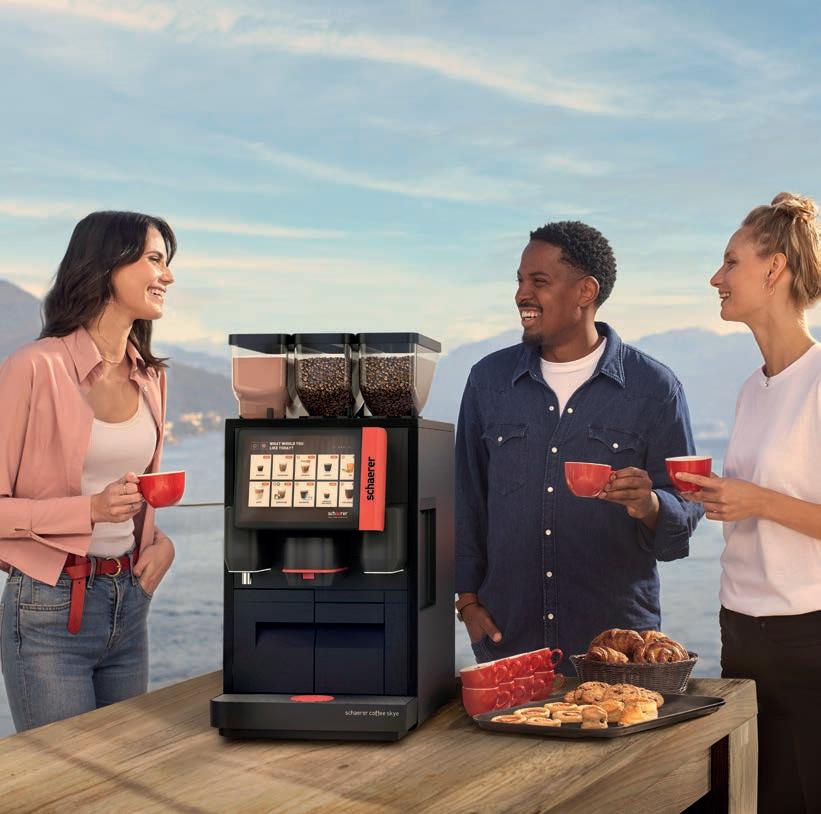
LÉGACY
EVERSYS IS UNVEILING LÉGACY ESPRESSO MACHINE: A NOD TO THE PAST AND A SIGN OF THE FUTURE, A PLACE WHERE FLEXIBILITY AND SPACE ARE NO BARRIER TO COFFEE QUALITY.

In 2009, Eversys Co-Founder Jean-Paul In-Albon decided to make one of the most expensive and biggest machines in the world. As Group Director of Business Development and Marketing Kamal Bengougam describes it, Eversys was “sitting on the apex of the market pyramid, at the high end”. The risk was high as the product was launched ahead of its time, but it became the catalyst for Eversys’ journey into today’s super traditional machines.
“What the market failed to see, was the vision of Jean-Paul. Whether he knew it or not at the time, he was trying to become the first guy to develop a machine that could compete with traditional machines, at all levels,” Bengougam says.
When he joined Eversys in 2011, he envisaged the development of the much smaller Cameo machine, the first of its kind to maintain the C shape of traditional models, and the consistency and productivity of super automatics.
“We then went back and reinvented the old E’Line and called it Enigma. The challenge was what to do next. We knew at some point we’d want to play in the mass machine market and have a smaller machine with a reduced footprint, at a lesser cost without compromising on the quality of coffee – the DNA of Eversys. And that’s what we set out to do,” Bengougam says.
Head of R&D at Eversys, Jonathan Besse, was tasked with the challenge of building this very machine.
“We had to think about functional analysis, what was needed to build the smallest machine in the Eversys line with only necessary internal components. It had to be compact, with fewer parts, be easier to manufacture and offer a better price to the market. All these questions were answered in the concept phase,” Besse says.
“We used the experience we had gained working on Cameo and Enigma, remodelled the grinders, coffee brewing chamber and piston head from previous models, and repackaged them in a smaller body of work.”
Every inch of space had to be utilised. No mess and no wastage. In the end, what they achieved, Bengougam says, is “an incredible feat of engineering”.
Users can choose up to four integrated grinders in the one machine, and one power chamber, such as a chocolate hopper, which can also be divided in half and used with another powder, such as chai. Users can also house up to two types of dairy and non-dairy alternative milks.
Once drink recipes and profiles are entered into the menu, all the customer needs to do is to activate the buttons within a self-service environment.
“The machine is basically a chef – you give it your bespoke order and requirements, and it creates it. I love that it’s got variety, behaves according to need,” Bengougam says.
The first specifications for the design were created in January 2020, followed by the concept phase with Eversys engineers in March of the same year. Different models made of wood, lego, and cardboard were used in full scale to determine the arrangement of components before the wider design team was brought in to package the model.
Head of Design at Eversys, Alexandre Rossier, says the swift turnaround of the machine was thanks to fast and in-depth discussions and close collaborations with every department.
“We don’t work like other companies where there is clear division between the engineering team, product design and design team – we all work together and have very pragmatic discussions. This allowed us to achieve the goal from specification to market in a little over two years,” Rossier says.
The machine is compact at just 36 centimetres wide, 60 centimetres deep, and 64 centimetres high.
“We worked from the inside out. We started with the internal organs of the machine, then grew the machine around these internal components,” Rossier says.
“Everything in the machine has a purpose and functionality. Even the lines of the design

At just 36 centimetres wide and 64 centimetres high, the Légacy can hold up to four integrated grinders. have a function. The front of the machine needs to be robust because you don’t want the machine to be scratched. Even the gaps between all elements have a purpose, such as air flow.”
The symmetrical walls house the machine’s internal organs, making assembly easy from the back panel, and accessibility for maintenance intuitive from the front.
“The body of the machine is screwed together in just four parts. With a single screwdriver, you can raise the screen and the coffee-tea steam outlets of machine for full access,” Rossier says. “If we compressed the machine, we had to make it easier to access.”
Besse adds that a big addition to this model, while invisible to customers, is an update of the machine’s electronic platform which he says is an incredible benefit, upgrade for technicians.
For operators however, a smaller grill for air outlets is located on the sides of the machine on a recessed area so that even when the machine is positioned beside a fridge, air flow is not impeded.
The drip tray is thin to ease access to the coffee grounds tray, and the display screen is identical to the Enigma at 10-inches wide.
One of the other advantages to this new model, is its ability to clean itself. The integrated cleaning system comes with up to 20 cleaning configurations. Eversys-designed tablets can clean the coffee and milk chambers separately. At the end of each service, users can empty the grounds drawer, activate the cleaning, and walk away, with the cycle completed within 10 minutes.
To reduce the visual height of the machine, Rossier says the decision was made to position the one-kilogram capacity bean hoppers half on top of the machine, and half visible on the inside.
The frame of the machine is made out of aluminium, a material that is durable, scratch resistant, easy to handle and assemble, and allowed Rossier the best possibilities to style a unique shape with a strong character.
The Eversys team also needed to make sure the supply chain could handle its requirements. As such, it worked with local suppliers – those that could be visited within a day – located in Switzerland, Germany, or Italy. Close communication meant less reliance on shipping from China, and a reduced environmental impact. Thinking ahead, the team also launched critical parts orders 10 months in advance.
The Eversys Légacy houses up to four integrated grinders with maintenance accessibility to the machine’s internal organs via the back panel.
While the Enigma and Shotmaster machines are suited to high-volume productivity, and the Cameo for specialty coffee shops, this new model will be positioned for self-service convenience outlets and offices where space and quality matters.
“This really is a next generational product. The internal work on the grinder and brewing units is designed to be flexible and modular. It’s an evolution machine. We are bringing our experience of the past 10 years and preparing the market for the future,” Besse says.
“This machine is a statement of build quality and performance output is what Eversys always delivers: high quality in-cup quality, only at a more affordable price.”
When it came time to name this machine, Bengougam considered the purpose of this model. “A légacy is a gift from the past to future generations. Légacy is going back to the beginning, and that’s what this machine represents. It’s the vision of a team that went on a journey to create a story and developed a compelling yet authentic narrative,” he says.
“Légacy to me is a statement. It’s a sign of maturity as a company, and that’s what this machine represents.”
When Bengougam saw the finished machine for the first time, he knew it was destined to take the market by storm.
“The Légacy is a stunning metal-made machine at a lower price point, a product that does not compromise on quality. Imagine if you could buy a BMW 5 Series instead of a Ford at the same price point. Well, that’s what Légacy is. It’s like buying something you think should be worth a lot more than it is,” Bengougam says.
“When you’ve got a tight space and a small environment, you’ve got to be compelling with your concept and make money. Our vision has always been to make great coffee available to anyone, anytime, anywhere, and Légacy gives you the flexibility to do that.” GCR
For more information, visit www.eversys.com/en/
Bridging the gap
PROBAT’S SKILLED MANUFACTURING AND ENGINEERING HAS RESULTED IN THE NEW NEPTUNE 1000 DRUM ROASTER THAT PUTS MAINTENANCE IN THE SPOTLIGHT, AND FLEXIBLE SOLUTIONS IN THE HANDS OF ROASTERS.
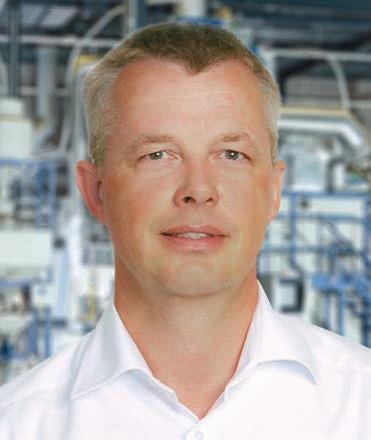

German manufacturer Probat has always strived to provide roasters with industry solutions based on their needs for volume, accuracy, and consistency, but there was one size drum roaster that had eluded its suite of machines, until now.
The new Neptune 1000 is Probat’s answer to customers asking for a mid-range drum roaster that sits between specialty coffee and commercial batch volumes.
“We know from discussions with our customers that we needed to bridge the gap between small to large roasters and provide a solution,” says Marco Petry, Probat Area Sales Manager Germany.
“There was no in between volume for the increasing number of specialty roasters, especially from Italy and Southern Europe, who are contemplating expansion, are on the verge of becoming bigger and looking to the next best option in terms of machine performance, size, capability and price point. Maybe they already have a Px120 drum roaster, but the next size in our range was the Neptune 1500 drum roaster, which is far too big.”
At the heart of Probat’s Neptune roaster is a horizontally lying roasting drum, equipped with a rotary drive. Shovel blades circulate the coffee beans during the roasting process. The flame of a burner generates the energy for the roasting air which is guided both through as well as around the roasting drum by means of flaps. Heat is applied through conduction via the hot incoming air, but also through conduction via the bean’s contact with the roasting drum.
To minimise maintenance downtime, Probat’s engineering team assessed how the machine was built and assembled at the factory, and how further technical changes could be implemented to assist servicing and accessibility.
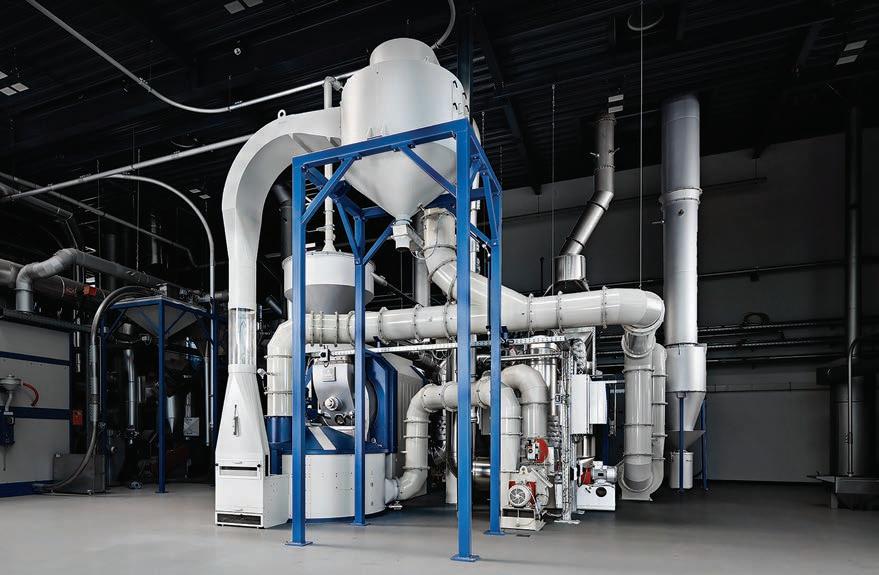
The Neptune 1000 is Probat’s solution for a mid-range drum roaster that caters between specialty and commercial batch volumes.
As such, engineers repositioned the motor on top of the cooling sieve, which was previously located underneath. This repositioning makes the cooling sieve much easier to clean. It also gives technicians direct access and replacement possibilities in case of engine defects, with drastically reduced downtime for operators. Other changes to improve maintenance include the use of a steel compensator rather than a fabric compensator to connect the heating oven, and there is now the possibility of rolling bearing inspection without dismantling the gear motor.
Thanks to the Neptune 1000’s hygienic and geometric design, the roaster is also easy to clean in a short amount of time. An enlarged inspection opening at the rear of the drum and at the bottom of the insulating hood on both sides of the machine has been created, and there is enhanced space and access to the burner chamber, roaster drum, and cooling sieve. Stainless-steel materials have also been used to avoid contamination of the end-product. A platform around the roaster can also be created as an optional addition to better access the aroma and smoke tubes, and filling hopper.
“Our engineers have considered every possible way a technician and roaster interacts with their roasting machine, and how they can best clean it, and access parts for regular maintenance. They work directly with our customers each day to understand their wants and needs and the Neptune 1000 is a reflection of that,” Petry says.
“This roaster really does represent considerations from every department of Probat, and we are convinced we have developed a machine that embraces how common problems are managed, and how we can reduce maintenance and ultimately downtime for our customers.”
The model has a modular design to allow customers to buy a variant of the model, built on a basic version, with the option to implement additional features based on customer needs, such as the addition of a recirculation system, and Proair cooling exhaust air treatment. This energy-saving solution treats airflow by passing through a series of cold plasma modules to eliminate odours from the cooling exhaust air, helping reducing odour pollution by up to 91 per cent.
To further avoid excreting harmful emissions and dust particles into the environment throughout the roast process, Probat’s high-efficiency cyclones with optimised flow processes ensure less dust deposits, effective chaff separation, and fast and clean disposal.
As part of the Neptune 1000’s modular feature, users can also select the exhaust air treatment system ranging from afterburner to thermal pre-cleaner with catalyser, to Proforte, the technological edge in exhaust air treatment in terms of energy and purification efficiency.
“It’s a careful balancing act between energy saving, high production performance and creating top-quality coffee,” Petry says.
To provide users with the ability to “play” and control their roasts, the PILOT Roaster 2020 control system enables operators to monitor roast temperature in real time, and view the roast profile and curve. Optionally, users can view the colour of the bean with Probat’s Colour Control measurement system. This quality control device determines a colour value or continuous colour curve throughout the roasting process, thus making reproducibility of the quality and desired taste even more consistent.
“The new PILOT Roaster 2020 control solution is the vital communication between human and machine. It’s an easy-to-understand, intuitive system that allows the user to always know what’s happening in the machine,” says Nico Moede, Probat Development Project Manager.
With its modern design and enlarged screen, users have a clear overview of the roasting process, with visual information and data about the timing and position of first crack. They can view versions of recipes, historic trending of process values, machine condition, and an error indicating system with provision for images, videos, and comments. The overall benefit is more clarity, less training, and cost savings thanks to the solution’s simplicity.
“The new operator menu makes control of the roaster easy to handle. Everything the roaster needs is on the screen in front of them, making for a more comfortable experience,” Petry says.
In addition, the Neptune 1000 has individually controllable frequency converters and thermocouples inside the roaster to control the drum speed and provide temperature-related information, such as supply air and product temperature, ambient temperature, and exhaust temperature to give the operator more control when developing roast profiles.
Petry says typically when roasters upgrade to larger industrial roaster – particularly specialty roasters – they lose the ability to “play” with the roaster’s features, such as the drum rotation and volume of fans, but with the Neptune 1000, operators can control the machine as much or as little as they like.
Probat Development Project Manager Nico Moede with the PILOT Roaster 2020 control system. Marco Petry is the Probat Area Sales Manager for Germany.
“We have provided roasters with every tool and function to be able to use and work the roaster to its optimum ability. All the tools are there to be played with if they desire. The level of flexibility is the real advantage. It’s the future,” Petry says.
The idea of flexibility extends to roast length based on market preference.
“Normally on a drum roaster, customers like to roast carefully between 14 to 20 minutes to bring out a high intensity of aroma and flavour of the bean. Many others, however, ask us if it’s possible to roast at a shorter time, such as six minutes,” Petry says. “The range of extended roasting time offers our customers the flexibility to create roasting profiles for any aroma development. Probat is a universal brand. Our roasting technology is flexible to meet any roaster needs, and the Neptune 1000 is a reflection of that. It can really do it all.”
The Neptune 1000 is due to make its digital launch via the Probat YouTube, Facebook and LinkedIn channels on 18 May before it’s released to the global market. Moede says when it does, he hopes customers feel that Probat’s technical and sales teams have listened carefully to their needs and delivered exactly what they wanted.
“The result is a really flexible, intuitive, state-of-the-art model that benefits not only our customers but technicians from a maintenance point of view,” Moede says. “The Neptune 1000 combines improvements and optimisation all in the one machine.” GCR
SKYE’S THE LIMIT
SCHAERER DISCUSSES HOW ITS NEW SCHAERER COFFEE SKYE MACHINE PROVIDES CUSTOMISED FLEXIBILITY FOR DIFFERENT APPLICATION SCENARIOS AND THE ADVANTAGE OF CONTACTLESS SOLUTIONS.

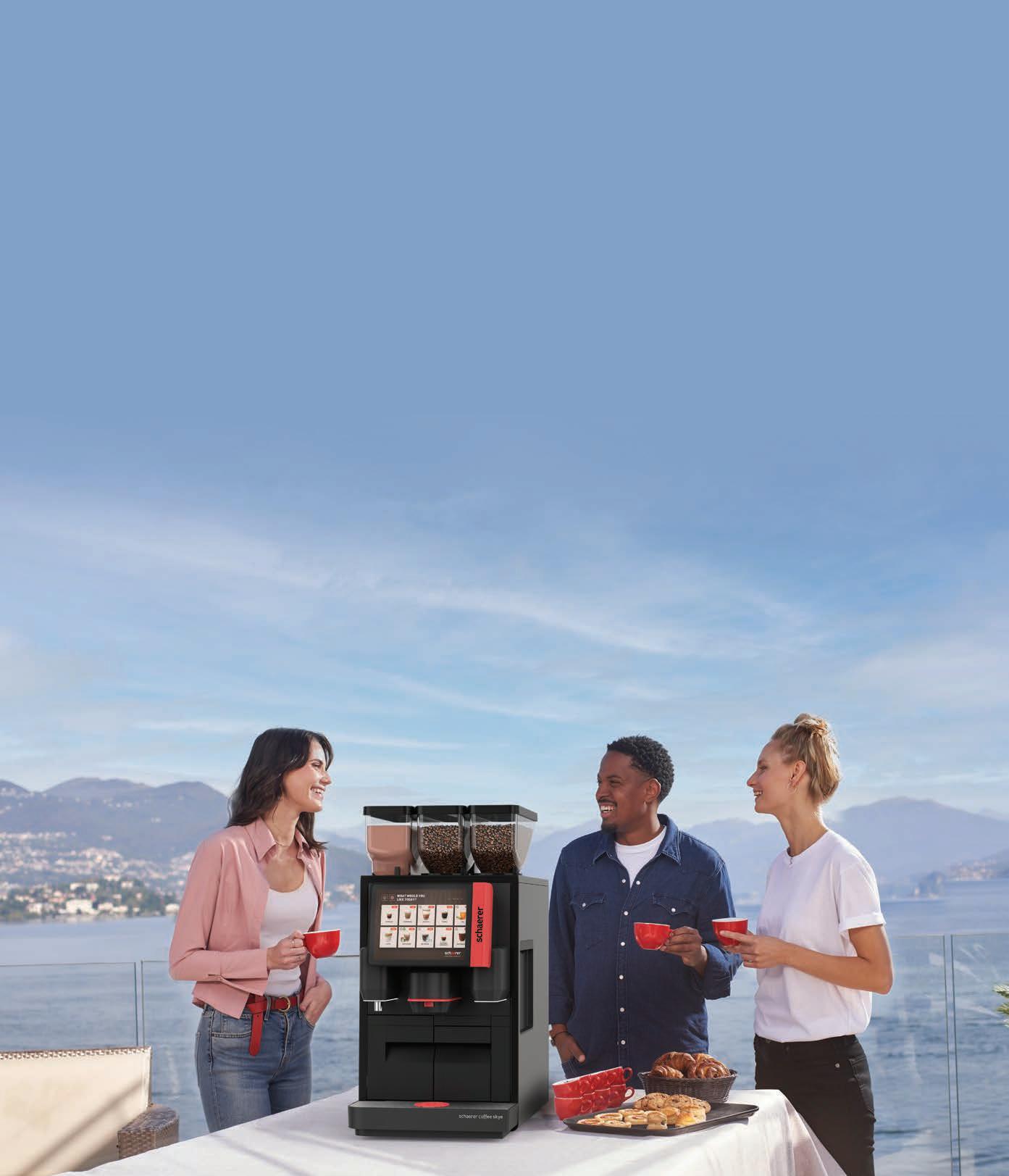
To swiss coffee machine manufacturer Schaerer, the flexibility to customise an order based on individual preference must coincide with beverage quality.
After the launch of Schaerer’s Coffee Soul machine, which caters to high-volume with a recommended daily output of 250 beverages, the Schaerer Coffee Skye is the next machine in the Schaerer portfolio to carer to individual customisation.
“The idea behind the Schaerer Coffee Skye was to cover the medium demand segment between the compact Schaerer Coffee Club and the high-performance Schaerer Coffee Soul,” says Product Manager Paulina Rueegger. “[The Coffee Skye] is well suited to small and medium-sized businesses with a recommended daily output of up to 180 cups of coffee. This includes small and middle restaurants, snack and non-alcoholic beverage bars, quick service restaurants, offices, or petrol stations, as well as mobile coffee concepts for events.
“The Schaerer Coffee Skye is a young, modern machine that embodies individuality, with the freedom to configure customer preferences to suit their needs. The machine is very convenient with its compact size, mobility, excellent coffee quality and its new milk system Pure Foam, producing creamy and poured milk foam.”
The Coffee Skye features the same graphical user interface (GUI) as the Coffee Soul, in 8-inch video capable high-resolution touchscreen.
The interface features large beverage icons for users to select up to two different blends thanks to two in-built grinders and up to two powder beverages in the one machine. The display can be adapted to the three most common application situations, such as frequent user mode, guest mode, or staff mode.
“For self-service operation, the guest mode is ideal. In guest mode, the selection is entirely guided and intuitive, with several steps allowing for the precise composition of the drink. It’s perfect for the breakfast area of a hotel, a company restaurant, a gas station, or a convenience store” says Rueegger.
“The staff mode is perfect for efficient preparation of the drinks in just a few steps thanks to pre-set drinks, pre-modifier and order list. Staff will find it easy and quick to use. Launching the preparation of the most common orders is almost instantaneous, while all the other recipes are immediately

The Schaerer Coffee Skye will be presented to the public for the first time at Internorga in Hamburg. accessible with minimum interaction.”
Unveiled to the public for the first time at the Internorga expo in Hamburg, Rueegger says the technical equipment and user profiles of the Schaerer Coffee Skye can be easily tailored to customer needs and applications.
Rueegger says while the machine development was met with some challenges, such as lack of supply and shipping delays due to the worldwide pandemic, it was important for Schaerer to add to its portfolio of models, and create a coffee machine with simplified construction, serviceability, and easy accessibility of components.
“We created an ambitious roadmap, with just over two years to complete the project. The effects of COVID-19 didn’t make it any easier, but the whole Schaerer team worked hard to develop the machine on time,” she says.
“We developed our first 3D printed prototype in August 2021. Because it was developed on time, it allowed us to fix any potential problems, make adjustments, and get the first internal feedback.
“Since then, we’ve field tested in Switzerland with eight machines and three machines internationally and have received very positive feedback from our customers.”
To cater for the current climate and increasing demand for convenience and hygienic self-service options, Schaerer’s Coffee Skye also features contactless preparation and payment processes.
“In these times of the coronavirus, the 2nd Screen, Touchless Outlet and Digital Payment Solution provide the self-service guest with a hygienic, contactless, and safe way to obtain the desired coffee drink,” says Regional Sales Manager Alex Prel.
For low-contact preparation of coffees, the 2nd Screen option allows beverages to be prepared from the smartphone of the guest, through contactless ordering.
“A QR code appears on the display of the coffee machine. The end customer scans it with their smartphone, then the available coffee specialties are displayed. Tapping on the smartphone starts the preparation process,” says Prel.
Another plus for hygienic operation is the Schaerer Digital Payment Solution, which allows for contactless payment with a smartphone.
The Schaerer Coffee Skye can be easily tailored to customer needs and applications.
“The Schaerer Digital Payment Solution is now making it easy to enter the world of mobile app payment. The Schaerer Digital Payment Solution is an integral part of the coffee machine software,” says Prel.
“After selecting the beverage, a QR code appears on the coffee machine touch display, which the guest scans with a smartphone to initiate the payment process.
“If the operator uses their own app or a scanner is connected to the self-service coffee concept, the digital playing field is even larger – from beverage creation in apps by coffee connoisseurs to the implementation of customer loyalty programs based on bonus systems or vouchers,” says Prel.
Schaerer coffee machines can also easily connect with customer-specific apps, software solutions and systems thanks to Schaerer Prisma, a local application programming interface (API).
“Schaerer Prisma opens up almost unlimited possibilities for customers to communicate with the coffee machine and create customer specific preferences or new user experiences,” says Prel.
The Schaerer Prisma also acts as a local connection that enables significantly faster data transfer than cloud-based APIs.
Prel says another innovative feature of the Coffee Skye is that the screen can also be used as an advertising tool.
“When the machine is not in use, it’s capable of automatically playing videos or displaying screen savers. This presents the opportunity for brand exposure, enhanced targeting, and personalisation, proficiencies that traditional machines can’t compete with,” he says.
Prel says thanks to Schaerer’s longevity as an almost 100-year-old coffee manufacturing business, customers can be assured by the company’s expertise and ability to deliver a quality product.
“That, and Schaerer’s individual approach, allows for greater flexibility,” Prel says. “We don’t produce machines on stock because every customer requires their own configuration of exact demand and usage. By producing machines only after receipt of order, it allows us to provide exactly what they need.
“Our goal is to think ahead with existing solutions when it comes to intuitive operation, process reliability, and to share our extensive knowledge with as many coffee enthusiasts as possible.” GCR
For more information, visit www.schaerer.com







